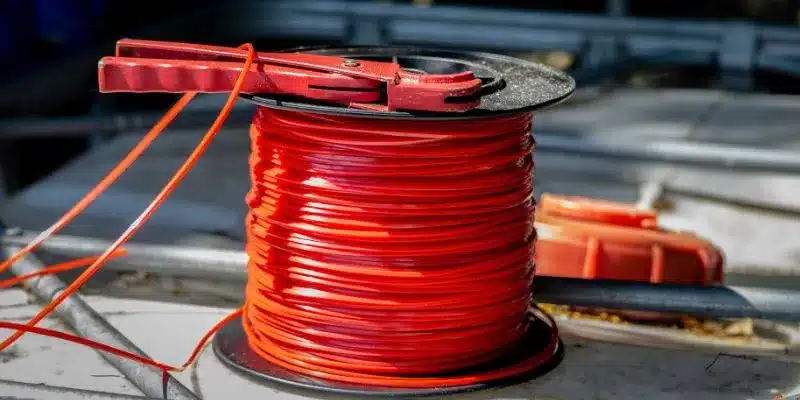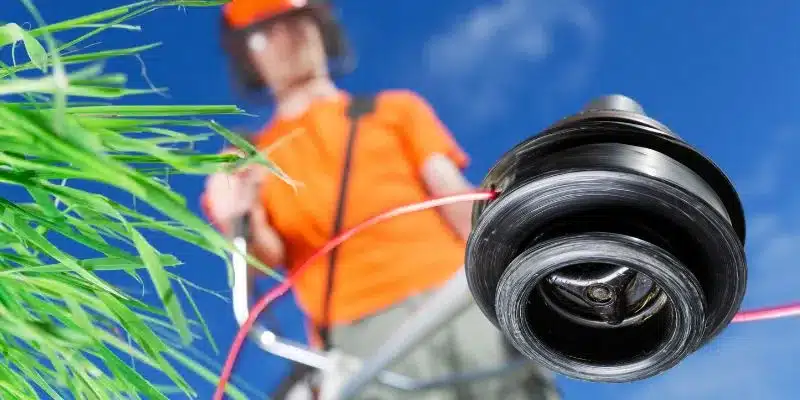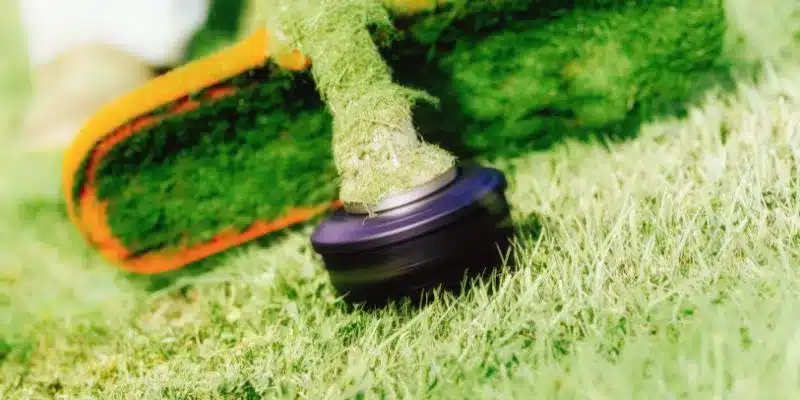Last Updated on April 18, 2024 by Sharaj
If you’re a gardening enthusiast, you probably understand the importance of having the right tools and equipment. Strimmers, also known as trimmers or weed eaters, are commonly used for lawn maintenance and getting rid of unruly weeds and grass.
But have you ever wondered if you can use cable ties on a strimmer to enhance its performance or tackle specific tasks more effectively? In this comprehensive article, we will delve into the world of strimmers and explore whether using cable ties is a viable option.
Let’s find out if you can use cable ties on a strimmer and how to do it safely.
Can You Use Cable Ties on a Strimmer?

One popular question that often arises among gardeners is whether cable ties can be used on a strimmer. The short answer is yes; you can use cable ties on a strimmer. However, there are some important factors to consider before doing so.
Using cable ties on a strimmer is not a traditional application, but it can be effective for specific tasks. Some gardeners prefer using cable ties as a makeshift solution for cutting thicker and denser vegetation that regular nylon lines might struggle with.
While it is possible to use cable ties on a strimmer, it’s essential to exercise caution. Not all trimmers are designed for this purpose, and using cable ties improperly can lead to damage to your petrol strimmer or even pose safety hazards. Let’s explore the pros and cons of using cable ties on a strimmer to make an informed decision.
Types of Strimmer Attachments
Before we discuss cable ties as attachments, let’s explore the different types of strimmer attachments available in the market. Understanding these options can help you choose the right attachment for your specific gardening needs.
Nylon Line: The most common strimmer attachment is a nylon line. It is suitable for cutting grass and light weeds, providing a clean and even cut.
Blades: Strimmer blades are more robust and are used for cutting thicker vegetation, including dense weeds and small bushes.
Brush Cutter: A brush cutter attachment is ideal for heavy-duty tasks, such as clearing dense undergrowth and tackling thick weeds.
Hedge Trimmer: Some strimmers come with hedge trimmer attachments, allowing you to shape and trim hedges easily.
Pros and Cons of Using Cable Ties
Using cable ties on a strimmer has both advantages and disadvantages. Let’s take a closer look at them to help you make an informed decision.
Pros:
- Cost-Effective: Cable ties are inexpensive and readily available, making them a cost-effective alternative to traditional strimmer attachments.
- Versatility: Cable ties can handle thicker vegetation, making them suitable for tough cutting tasks.
- DIY Solution: If you have cable ties at hand and face a strimming challenge, using them can provide a quick and temporary DIY solution.
Cons
- Safety Concerns: Using cable ties can increase the risk of debris scattering, which can be dangerous for the operator and those nearby.
- Strimmer Compatibility: Not all strimmers are designed to handle cable ties, and using them on an incompatible strimmer may cause damage or void the warranty.
- Inconsistent Performance: Cable ties might not provide the same precise and even cutting performance as dedicated strimmer attachments.
Choosing the Right Cable Ties

If you decide to use cable ties on your cordless strimmer, it’s crucial to choose the right ones for the job. Here are some factors to consider when selecting cable ties:
Material: Opt for cable ties made from durable materials like nylon, which can withstand the rigors of cutting vegetation.
Length and Width: Choose cable ties of an appropriate length and width that fit your strimmer’s cutting head securely.
Tensile Strength: Ensure that the cable ties have sufficient tensile strength to handle the cutting force without breaking easily.
UV Resistance: If you intend to use the strimmer in sunny conditions, look for cable ties with UV resistance to prevent premature degradation.
Disposable vs. Reusable: Decide whether you want to use disposable cable ties for one-time tasks or reusable ones for multiple uses.
How to Safely Use Cable Ties on a Strimmer
Safety should always be a top priority when using any gardening tool, including cable ties on a strimmer. Follow these guidelines to ensure safe and effective usage:
Check Strimmer Compatibility: Before attaching cable ties, verify that your strimmer is compatible with this method. Refer to the manufacturer’s instructions and guidelines.
Wear Safety Gear: Always wear appropriate safety gear, including goggles, gloves, and sturdy footwear, to protect yourself from debris and potential accidents.
Securely Attach Cable Ties: Fasten the cable ties securely on the strimmer’s cutting head, ensuring they are evenly spaced for balanced cutting.
Inspect the Area: Before starting, inspect the area you’ll be strimming. Remove any rocks, debris, or obstacles that could cause damage or pose hazards.
Adjust Cutting Height: Set the strimmer’s cutting height to an appropriate level for the type of vegetation you’ll be tackling.
Start Slowly: Begin strimming at a low speed to gauge the performance and adjust as needed before tackling denser areas.
Maintain a Steady Pace: Maintain a consistent walking pace while strimming to achieve an even cut and reduce the risk of tangling or damage.
Monitor Cable Ties: Keep an eye on the cable ties during usage. If any break or become loose, stop immediately and replace them.
Avoid Wet Conditions: Strimming wet vegetation with cable ties can lead to reduced cutting efficiency and potential hazards. Opt for dry conditions whenever possible.
Store Safely: After use, store the strimmer and cable ties in a secure and dry location, away from the reach of children and pets.
Tips for Using Cable Ties on a Strimmer
To make the most out of using cable ties on your strimmer, consider the following tips:
Experiment with Lengths: Test different cable tie lengths to determine which one provides the best cutting performance for your specific strimmer.
Regular Maintenance: Keep your strimmer clean and well-maintained to ensure optimal cutting performance and longevity.
Alternate Attachments: Combine the use of cable ties with traditional nylon lines or blades for more versatile cutting options.
Practice Makes Perfect: If you’re new to using cable ties on a strimmer, practice in a controlled area before tackling your entire garden.
Use High-Quality Cable Ties: Invest in high-quality cable ties to ensure better performance and durability.
Frequently Asked Questions about Using Cable Ties on a Strimmer
Can I use any type of cable ties on my strimmer?
It is essential to use cable ties made from durable materials like nylon and ensure they are compatible with your strimmer’s cutting head.
Will using cable ties on my strimmer void the warranty?
Some manufacturers may void the warranty if cable ties cause damage to the strimmer. Always check the warranty terms before using cable ties.
Can I reuse cable ties on my strimmer?
Reusing cable ties is possible if they remain in good condition. However, it’s generally recommended to use new ones for optimal performance.
Are cable ties suitable for cutting tough weeds and thick vegetation?
Yes, cable ties can be effective for cutting tough weeds and dense vegetation that traditional nylon lines might struggle with.
Is it safe to use cable ties on a strimmer?
When used correctly and on compatible strimmers, cable ties can be safe. However, it’s essential to follow safety guidelines and exercise caution.
How long do cable ties last on a strimmer?
The lifespan of cable ties on a strimmer depends on the quality of the ties and the intensity of usage. High-quality ties can last several uses.
Conclusion
Using cable ties on a strimmer can be a practical solution for specific cutting tasks. However, it’s crucial to be aware of the safety concerns and ensure compatibility with your strimmer.
If you decide to use cable ties, choose high-quality and durable ones that meet your strimming needs. Remember to prioritize safety, wear appropriate gear, and follow the guidelines for effective and secure usage.
In conclusion, cable ties can be a valuable addition to your gardening arsenal when used responsibly and with proper precautions. By making an informed decision and following the tips provided, you can enhance your strimmer’s cutting capabilities and tackle even the toughest of vegetation with ease.

